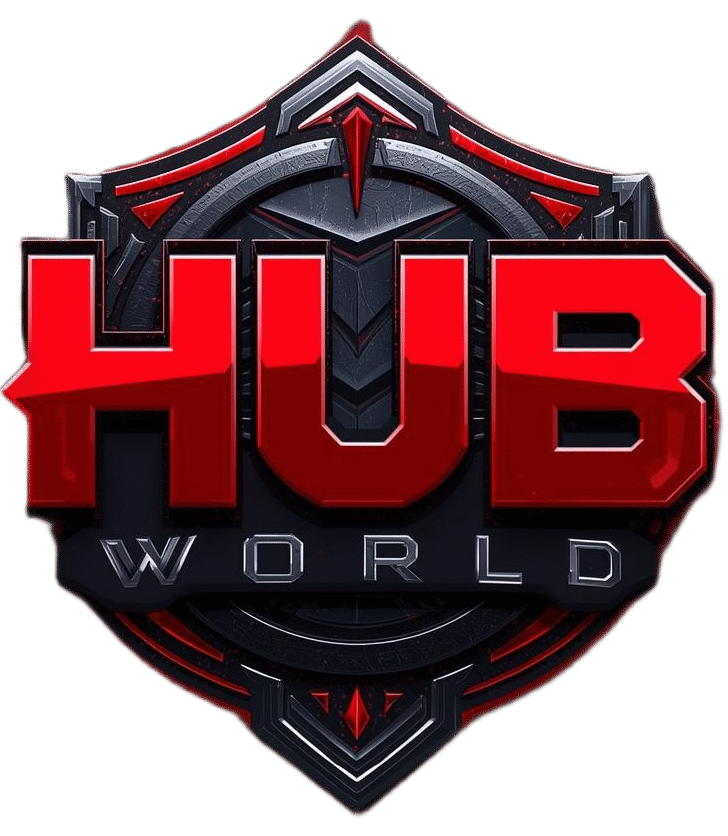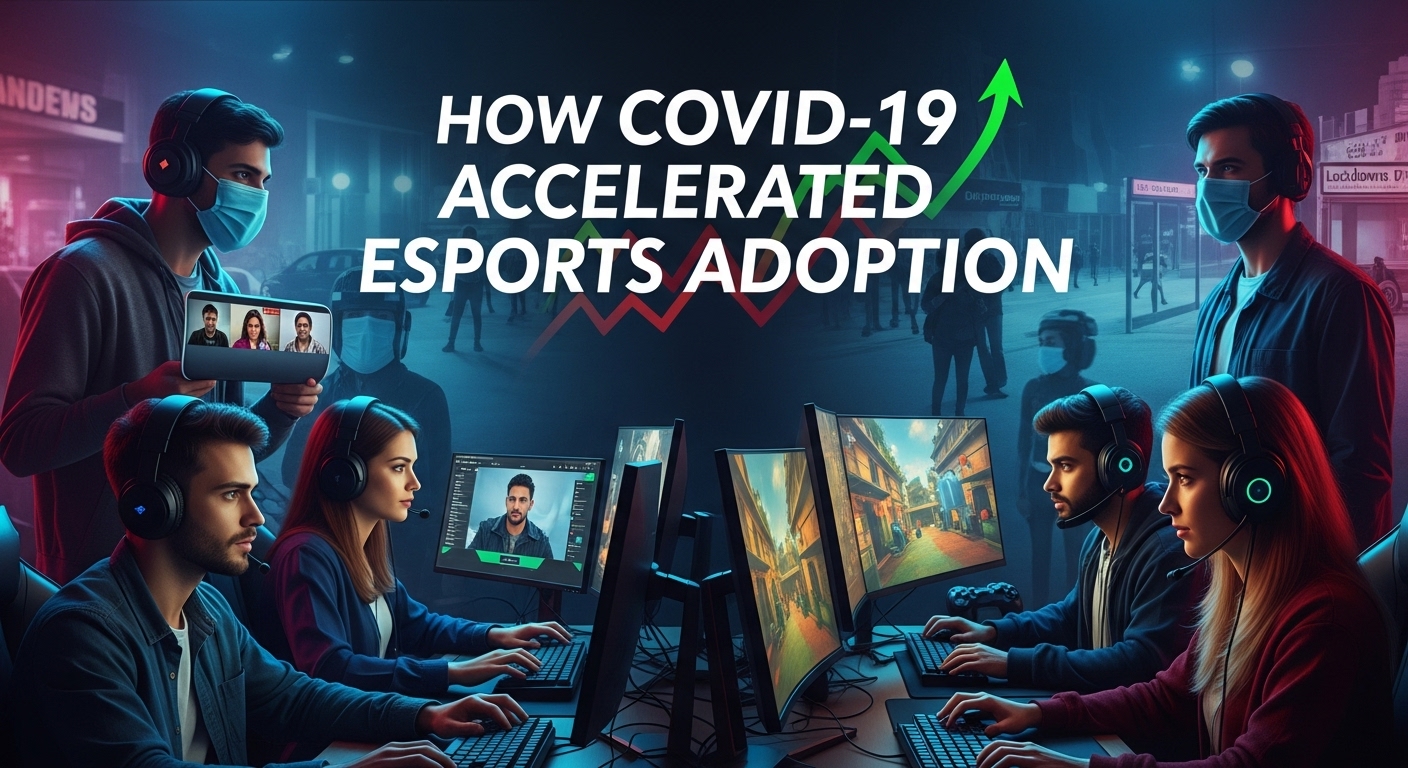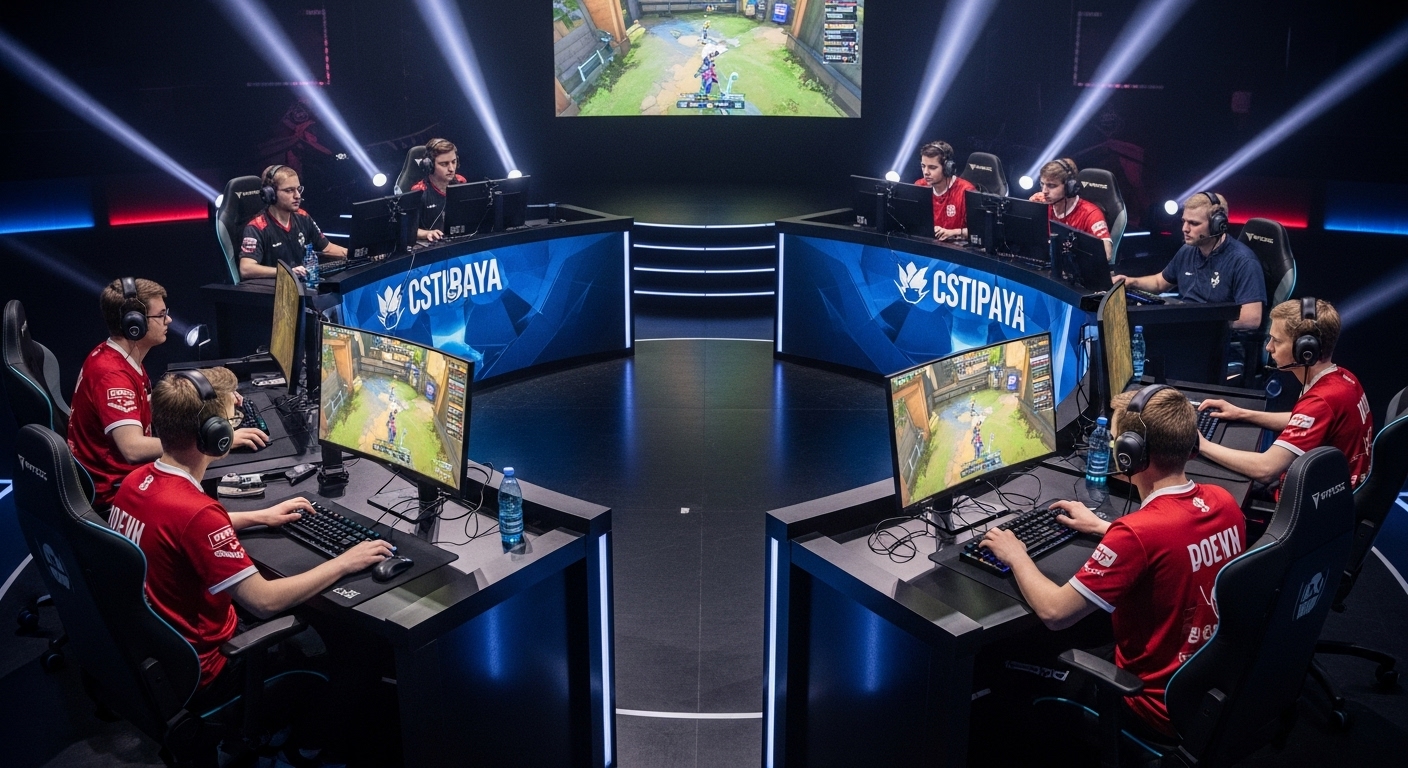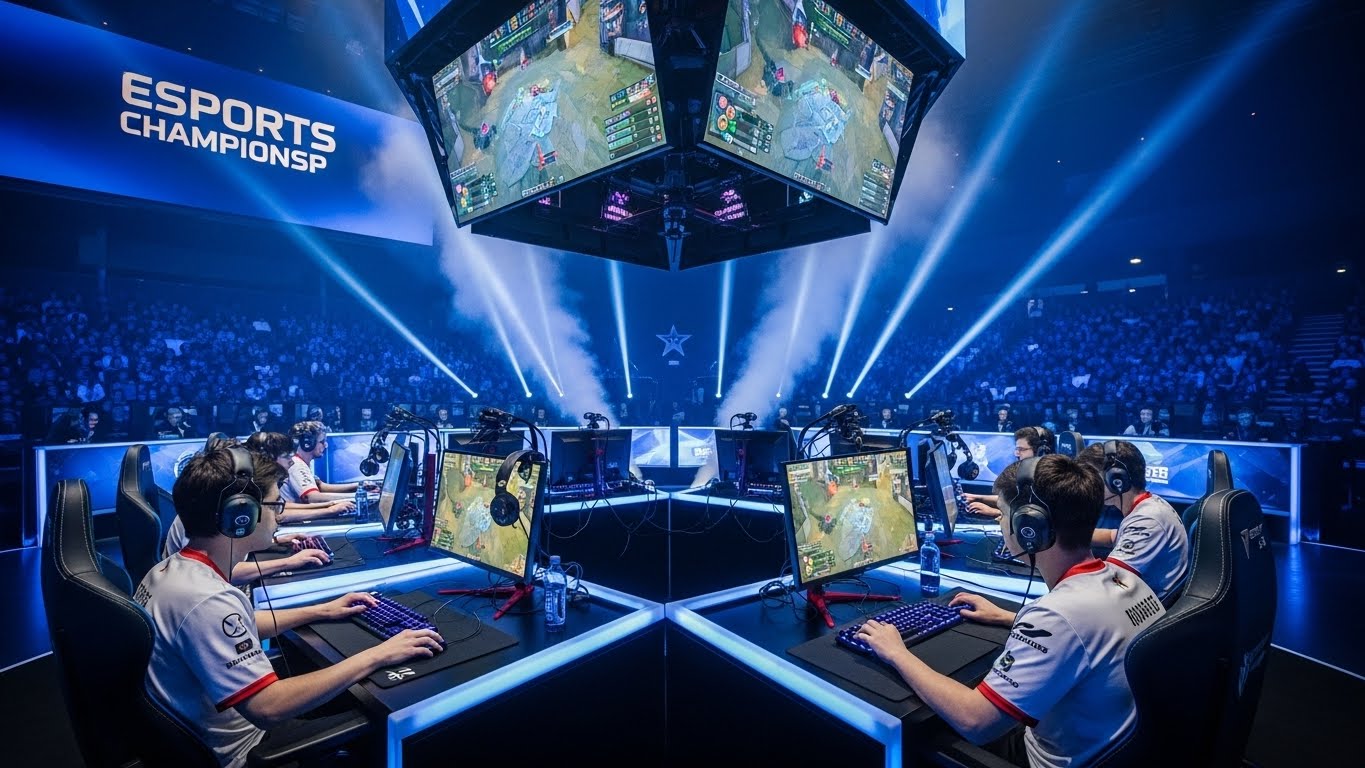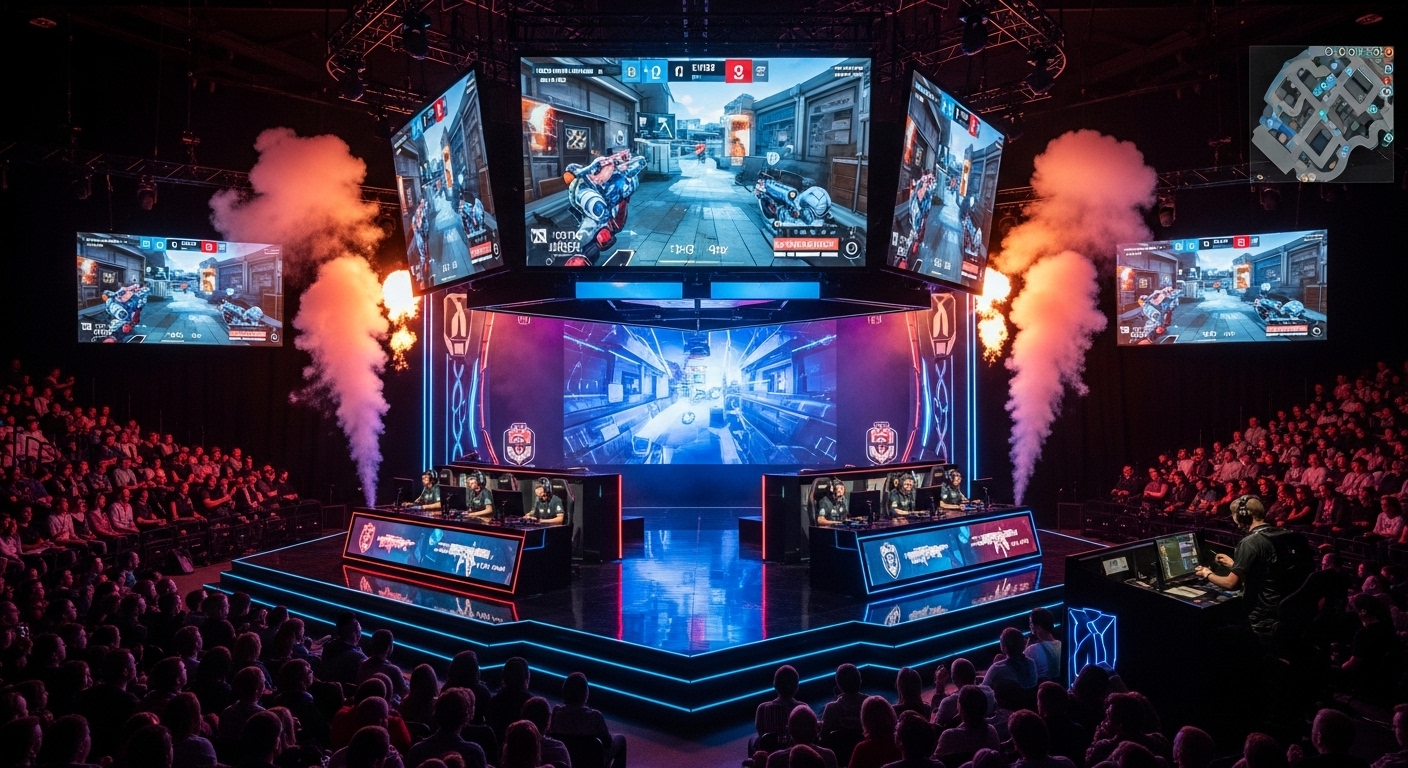When COVID-19 forced the world indoors in early 2020, whole industries were knocked sideways. Live music and conferences stalled. Traditional sports paused or played to empty arenas. For esports, the shutdowns created a paradox: the physical infrastructure of big tournaments — arenas, on-site spectators, production crews — vanished practically overnight, but the raw demand for live entertainment, social connection, and digital distraction exploded. The result was a rapid, messy, and ultimately transformative acceleration of esports adoption. This post unpacks how that happened: the immediate shock, the digital pivots organizers and players made, the surge in audiences and sponsorship interest, and the long-term changes in business models, talent careers, and mainstream perception.
1. The perfect storm: why esports was primed to scale during a pandemic
Esports arrived into the pandemic with several structural advantages:
- Digital-first delivery. Matches were already produced for online streaming; no physical spectators were required for a broadcast to reach millions. Unlike stadium sports that had to invent new ways to film empty arenas, esports was largely practiced and consumed online from the start.
- Distributed talent and teams. While many tournaments relied on LAN (local area network) setups for competitive integrity, pro players were comfortable living and practicing online; teams already used Discord, tactical voice comms, and remote bootcamps. That made it much easier to switch to fully remote formats when necessary.
- A generation comfortable with streaming. Millions of fans already consumed hours of content on Twitch, YouTube Gaming, and other platforms. When lockdowns began, those platforms became a default social space, not only for watching matches but for hangouts, charity streams, and community events.
These conditions didn’t create esports growth by themselves, but they meant that esports organizations had fewer technological and cultural barriers to scaling their audience quickly compared with many other entertainment sectors.
2. From canceled arenas to online marathons: the operational pivot
In March–April 2020, the calendar of every major esports circuit and tournament was littered with cancellations and postponements. Organizers had to choose fast: cancel, delay, or reformat events for online play. Many chose the latter. Professional leagues — from regional pro circuits to international championships — moved matches to remote play, using a mix of cloud-based production tools, remote player setups, and strict anti-cheat/latency protocols.
Some flagship events managed to survive in adapted forms. Riot Games’ major competitions (including the League of Legends ecosystem) were reworked into remote or tightly controlled bubble environments depending on region and local restrictions. The logistical complexity was enormous: travel quarantines, secure remote servers to reduce cheating, and live broadcast teams working under lockdown constraints. Yet these shifts allowed tournaments to continue and kept audiences engaged during a year when live alternatives were scarce. ESPN.com+1
3. The numbers: audience and revenue growth during 2020–2021
A few headline figures help quantify the impact:
- Streaming hours and platform usage surged. Reports from the pandemic period show massive increases in time spent on streaming platforms — Q3 2020 saw platforms recording billions more hours watched than the previous year. For instance, quarterly viewing numbers jumped dramatically across platforms as people looked for entertainment while confined at home. also.com+1
- Esports market revenue held up and continued to grow despite on-site ticket losses. Industry estimates for 2020–2021 projected year-on-year growth in total esports revenues, driven by media rights, sponsorships and streaming monetization even as live ticketing revenue declined or disappeared. Newzoo’s market reports during that period show the market moving into the billion-dollar range, with growth continuing into 2021 as organizers adapted. Newzoo+1
These figures don’t mean everything rose evenly — some leagues and formats performed better than others — but overall they illustrate the counterintuitive result of a global pandemic: many parts of the esports ecosystem expanded when other live industries contracted.
4. Why viewership spiked (and what that viewership looked like)
Viewership growth during the pandemic had several drivers:
- A captive global audience. Lockdowns created more available free time and increased the desire for live, social entertainment. Esports streams — live, interactive, and often social — filled that gap.
- Cross-pollination from creators and celebrities. Big-name streamers, content creators, and even traditional celebrities held charity streams, exhibition matches, and variety game content that introduced casual viewers to competitive formats. Celebrity involvement and mainstream media coverage brought in new audiences who might not previously have considered watching esports.
- More accessible schedules and local content. With physical events canceled, regional and online events filled programming schedules. Fans could more easily follow teams and players without worrying about time zone–conflicted live attendance.
For platforms like Twitch, overall hours watched surged during the pandemic quarters — figures circulated showing large percentage increases year-on-year — and a significant chunk of that growth was tied to esports and competitive content and to creators who combined entertainment and competitive play. scholarworks.gsu.edu+1
5. Sponsorship, media rights, and the money question
One of esports’ long-term puzzles has been the monetization model. Pre-pandemic, there were big expectations for ticket sales, franchising, sponsorships, and media rights. The pandemic accelerated some revenue streams, shifted others, and revealed weaknesses.
- Media rights and sponsorships became more central. With physical attendance curtailed, eyeballs on broadcasts became the most valuable asset. Brands redirected more of their marketing dollars to digital sponsorship and streaming activations. Newzoo noted that media rights and sponsorship were dominant revenue sources and expected to account for a large share of total esports revenue during the 2020–2021 period. Newzoo
- Ticketing and live event income collapsed short-term. For organizations that had invested heavily in live-event experiences (stage builds, local marketing, stadium deals), the loss of ticket revenue was painful and exposed the risk of relying too heavily on in-person income.
- Sponsorships became more creative and integrated. Brands increasingly experimented with in-stream integrations, influencer partnerships, and digital activations — learning how to measure ROI in clicks, watch time, and engagement rather than stadium attendance.
In short: COVID tested esports’ business fundamentals and, in many cases, pushed organizations toward more digitally native monetization models faster than they might have otherwise moved.
6. Players, teams, and careers: new paths opened (and old ones stressed)
For players and organizations, the pandemic accelerated two parallel trends.
First, the creator economy became a viable alternative (or complement) to pure roster income. Many pro players who already had streaming channels doubled down on content creation when tournament schedules shrank; the lines between “pro player” and “content creator” blurred. Platforms rewarded regular streaming with subscriptions, donations, and sponsorship deals — sometimes offering more stable income than inconsistent tournament winnings. Wired and other outlets documented the pivot of players and some organizations toward influencer-driven strategies during this time. WIRED
Second, mental health and performance received new scrutiny. Remote competition and travel stoppages meant players practiced in isolation more often, with less face-to-face team time and coaching support. The pandemic highlighted the importance of structured schedules, sports psychology, and organizational support for pro gamers — all now more mainstream parts of pro team management.
7. Innovation: production, formats, and hybrid events
Necessity breeds innovation. When LAN events and packed arenas became infeasible, organizers tried creative alternatives that often stuck around afterward:
- Enhanced remote production. Operators improved the quality of remote broadcast production: better remote camera setups, standardized player hardware checks, latency-compensation tools, and distributed production pipelines that allowed commentators, casters, and producers to work from home. These practices reduced event overheads and made cross-border production more resilient.
- New competitive formats. Several leagues experimented with reduced rosters, regional bubbles, and invitationals that paired pro players with streamers or celebrities. Some exhibition formats — short-form, entertainment-first matches — attracted casual viewers who would later explore competitive ladders.
- Hybrid models. As regions reopened, hybrid events emerged: small live audiences, big remote production, and richer online interactive features (live polls, viewer rewards, and in-stream overlays). Hybrid models promise the emotional punch of physical attendance with the scalability and interactivity of streaming.
These innovations didn’t just plug gaps — they created new product lines and audience experiences that organizers continue to use. repository.usfca.edu
8. Grassroots and collegiate ecosystems: unexpected winners
While pro circuits grabbed headlines, grassroots and collegiate esports also saw notable shifts:
- Growth in collegiate adoption. With campus life constrained, many universities invested in structured collegiate esports programs as a recruitment and retention tool. The infrastructure — campus esports arenas, scholarship programs, and organized leagues — gained traction during the pandemic and continued afterward as campus life normalized. Research into collegiate esports during COVID documented how programs adapted and, in some cases, expanded. PMC
- Local communities moved online. Local LAN cafés and arcades struggled under restrictions, but online community tournaments, meetups, and smaller-scale leagues flourished. While this shift endangered some physical hubs (notably in regions with a strong arcade culture), it broadened participation opportunities for players who couldn’t previously travel to physical events. WIRED
9. Challenges and fragilities the pandemic exposed
The period of accelerated adoption wasn’t all upside; COVID also exposed structural weaknesses:
- Overreliance on a few platforms. When the majority of audience attention consolidated on platforms like Twitch and YouTube, ecosystems became vulnerable to platform policy changes, ad market fluctuations, or shifts in viewer behavior (e.g., shorter watch sessions).
- Fragmented monetization. Not every organization benefited equally. Those that were heavily invested in live events or lacked strong digital engagement channels struggled financially even as viewership numbers rose.
- Operational risk in remote play. Remote formats introduced new technical vulnerabilities: variable latency across regions, increased cheating risks, and occasional server instability. Some competitive integrity questions remain tough to solve at scale.
- Inequality across regions and games. Some titles benefitted enormously (battle royale, MOBAs, FPS games with strong streaming cultures), while others floundered. Likewise, regions with robust digital infrastructure (North America, parts of Europe, China, South Korea) fared better than those with patchier connectivity.
10. The cultural shift: esports moved further into mainstream conversation
Perhaps the most enduring change is cultural. Esports moved from a niche hobbyist phenomenon toward mainstream entertainment. Several cultural signals showed the shift:
- Celebrity investment and attention. Mainstream celebrities and athletes made investments or launched teams, adding visibility and signaling commercial legitimacy. News coverage around these moves intensified during 2020–2021. The Guardian
- Brands pivoting to gaming audiences. Major non-endemic brands (consumer goods, finance, apparel) increased sponsorship and co-branded content, seeing esports as a way to reach engaged younger demographics.
- Cross-industry experiments. Collaborations between music artists, game companies, and esports orgs (virtual performances, branded in-game events) normalized the idea that esports could be part of a broader entertainment strategy.
These signals changed mainstream perception: esports was now an attractive channel for marketing, media rights deals, and creative partnerships.
11. What stuck: long-term changes to the esports landscape
Not every pandemic-era experiment survived intact — some were smoothing events that later adjusted back — but several changes have proven durable:
- Digital-first monetization remains a priority. Media rights, sponsorship activations, in-stream commerce, and creator partnerships continue to dominate revenue discussions.
- Hybrid event formats are now common. Organizers combine smaller in-person audiences with high-quality online broadcasts and interactive features to maximize reach and resilience.
- Talent diversification. Players often have parallel careers as streamers and content creators. Teams value creators for stable revenue and audience development.
- Operational resilience. Distributed production systems and improved remote competition tools remain in place, lowering future barriers for international events and making the ecosystem less brittle.
These shifts mean that even in a post-pandemic world, esports is structured differently than it was in 2019. The industry not only survived a global shock — in many ways it matured through it.
12. Two case studies: what worked (and what didn’t)
Case study A — A game with explosive pandemic momentum. Some titles saw viewership multiply during lockdowns because their communities were already streaming-friendly, and because developers leaned into event content and creator partnerships. Streamers and pro tournaments fed each other: creators boosted game visibility, and tournaments gave creators fresh content. The combined feedback loop accelerated adoption among casual viewers.
Case study B — A league overextended on live event economics. Not every model weathered the storm. Leagues that had invested heavily in stadiums, local partnerships, or long lead-time events found the sudden stop of live attendance catastrophic. Some had to reconfigure investor expectations, restructure team contracts, or lean harder into content-creation revenue to survive.
These contrasting outcomes illustrate that pandemic acceleration benefited businesses that were digitally agile and diversified their revenue streams; it punished those with single-point dependencies on live events.
13. The regulatory and social context: moderation, safety, and inclusion
As esports grew in attention, it attracted scrutiny around moderation, toxicity, and workplace issues. The pandemic’s move to online work made these issues more visible. Organizations had to invest more in player welfare, harassment mitigation, and community moderation systems. This created both a challenge and an opportunity: better governance and professional standards can improve sponsorship prospects and open esports to broader audiences.
14. Beyond the pandemic: what the future looks like
Predicting the future is never a sure thing, but COVID set a few trajectories that seem likely to continue:
- Esports will remain a hybrid of competition and entertainment. Purely competitive products and spectacle-driven events will coexist; the most successful organizations will be those that can operate across both poles.
- Content creators will be central to fan engagement. The creator economy’s momentum gives players and streamers more negotiation power. Teams will invest in creators, and creators will solidify their channels as pillars of the fan experience.
- Data and interactivity will drive monetization. Brands will want measurable engagement. Interactive ad formats, in-stream purchases, and viewer data (ethically collected) will be key.
- Access will expand — but so will competition. As more traditional media and entertainment firms enter gaming and esports, the space will professionalize further. That’s great for long-term market size, but it raises the bar for new entrants.
15. Lessons learned for organizers, brands, and talent
If there’s a practical takeaway from COVID’s acceleration of esports adoption, it’s this:
- Diversify your revenue and audience channels. Don’t rely solely on ticketing or a single platform. Build creator partnerships and ownable content.
- Invest in resilient operations. Distributed production, secure remote play infrastructure, and contingency planning matter.
- Treat players as people. Mental health, structured schedules, and career planning (including creator opportunities) will improve retention and performance.
- Experiment boldly, measure ruthlessly. The pandemic rewarded experimentation — but the winners measured what worked and iterated quickly.
16. Final thoughts: a pandemic, a pivot, and a more mature industry
COVID-19 was a brutal stress test. It forced esports to operate without one of its growing margins of revenue (live events) while placing it squarely into the spotlight as millions sought digital connection. The result was messy and unequal: some organizations thrived, others struggled. But across the board, the industry learned to be more digital, more creative, and more integrated with the wider entertainment economy.
